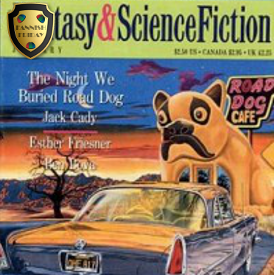
I feel it’s important, if you’re reading a review or opinion on a book, movie or whatever, that you know what the reviewer’s prejudices are; likes and dislikes, affiliations and so on. That way you can decide just how much weight you can assign to that review before deciding to lay down your hard-earned shekels for whatever is being talked about. With that in mind, let me give you a really shortened version of Steve.
I’m probably older than you; I’m male, mostly Caucasian and grew up in the US. I moved to Canada just under 30 years ago, and was in the US Navy during the Viet Nam war (no, I didn’t fight in that war). I’ve lived in places as diverse as Duluth, MN, Yuma, AZ and Aldeburgh, Suffolk, in England—though I’ve never been farther east in Canada than Winnipeg. I have held the “writers’ list” of jobs during my working years—from cauliflower picker for Dole (or Libby’s or Campbell’s—not entirely sure which) to California cop; now I’m retired I’m trying to write full time—at least that part of the time that I’m not being a “house husband” for a working wife (the Beautiful and Talented Lynne Taylor Fahnestalk) and owner/staff for a 5-year-old cat, Chester.
I like “hard SF,” “high fantasy” and everything between (Stephen King’s a fave, though he could—like many best-selling authors—benefit from an editor’s “no!” once in a while). I like many newer writers, like the late Jay Lake, Cherie Priest, Susan McGregor, etc.; I also like Robert Silverberg, Hal Clement, Jim Butcher, Eric Flint and so on.) Musically, I like Beethoven to Beatles, Heather Dale to Dick Dale; just about anything except “house” and “techno”—I find those repetitious and boring, because I don’t go clubbing. I think some hip-hop and rap has clever lyrics, but overall I don’t listen to them. TV-wise, the only “reality” shows I like are those where you actually learn something, like cooking shows or Antiques Roadshow, both British and American versions; I’ve never watched—and will never watch—any Survivor, Big Brother, Kardashians, Real Housewives or shows where there are people tearing each other down. I like TV shows about smart people—Jeopardy, Elementary, Sherlock, The Mentalist; and not about the other end of the spectrum: won’t watch Duck Dynasty, Trailer Park Boys or any of that ilk.
Movies I like range from SF/fantasy to action/adventure to (a few) rom-coms and plain old dramas; I’m particularly fond of old (and some modern) B-movies; during the first two years of our 25-year marriage Lynne and I watched (mostly on video) something like six or eight hundred B-movies. I think Tom Cruise is a kind of an idiot; oddly, I’ve liked many of his movies. I love “caper” movies, like the original Ocean’s Eleven and the three recent “Danny Ocean” movies; some favourite modern male stars are Johnny Depp and George Clooney, but I like older UK actors like Bill Nighy, Judi Dench and Brendan Gleeson, as well as many old black-and-white movie stars like Cary Grant, Katherine Hepburn, Lauren Bacall (and, of course, Bogey) and so on. I detest the modern run of so-called comedies that depend on genital jokes, excretion jokes and so on, instead of character-based or situation-based comedy. I’d even watch Bedtime for Bonzo instead of, for example, The Hangover Part III (of which I’ve seen a small but disgusting clip). So, yes, in some respects I’m a grumpy old(er) man. I refuse to be old; I’m capable of change.
Enough about me, what about you? (As the old joke has it, “What do you think of me?”) But seriously, folks (I’m here all week, don’t forget to tip your waitperson!), I’m here to talk about books, specifically The Necromancer Candle, by Randy McCharles (Edge Publishing, 2014, $14.95 CDN, Figure 1). I picked it up at VCON (see last week’s column) as well as a few other books that will appear in future columns. Randy is an up-and-coming fantasist who, I’m convinced, will continue to improve to a very high level.
First, a word about publishers, especially small publishers—and by that I mean any non-major house, like Tor is. Although they usually turn out a product that looks as professional as the “big boys,” I really, really wish they could afford to hire editors—not only the kind of editors Stephen King needs, but copy editors as well. Although I’m pretty familiar with Edge Publishing, and its proprietors Brian and Anita Hades, the McCharles book is the first Edge I’ve bought. A decent copy editor would have caught the myriad spelling and punctuation errors in this book; one of the pages is even miscut, bound in at an angle. (Actually, that’s not the publisher’s fault; one can’t inspect every copy that comes out of the binder page by page.) But all that detracts from my enjoyment, at least, of the book’s contents. As we used to say in our writers’ group, Writers’ Bloc, these things are “poppers”—they pop you out of the story. (And for those of you who say “language is constantly changing,” I counter with “there are certain basics that haven’t changed in my lifetime. Spelling and grammar are among them.”) It’s all part of professionalism. (And sorry to keep harping on Edge, but the cover is a really “blah” generic piece; is it supposed to represent a scene from the book? There are so many good Canadian SF/F artists, I think they could have gotten a better and more attractive cover for the book.)

Okay, but what about the contents? This book comprises three novellas: “The Necromancer Candle,” “Full House,” and “Merlin’s Silver.” All three are what we’d call “urban fantasy,” although the first—“Necromancer Candle”—begins in some unspecified medieval time (actually, the 12th century). There is a tinge of violet in some of the prose: “The wind outside the bone house howled with the agony of whole herds of pigs being slaughtered, their moist flesh thrown onto the coals…” (the above being from the viewpoint of Jiri, who works for the bonemaster, rending tallow from the fat, skin and bones of said slaughtered pigs). There is a pretty vivid description of a man being rendered down to tallow for his fat, the same to be made into candles; although I don’t know enough to know just how real the process is as described, it seems realistic. The action then shifts into modern day, where those same necromantic candles are being used for nefarious purpose. The protagonist, Cassidy, inheritor of one of those candles, works (surprise!) in a candle shop in Los Angeles; an unnamed person has killed her mother and ransacked the shop in search of the missing candle.
Cassidy’s father had disappeared about a year previous, when it was found that she had terminal cancer; she is being taken care of by a family friend after her mother’s death, even though her doctor wishes she’d stay in the hospital for what remains of her life. Cassidy, however, wants to stay out of the hospital as long as she has the strength to carry on, but there’s a catch—an officious Child Welfare person, who knows Cassidy’s parents aren’t around, is trying to find her to have her put in a home. Now that her mother is dead, her father has also returned home, but is afraid Cassidy will reject him. The rest of the drama plays out against this background; these are the interesting bits… the supernatural part of it wasn’t that exciting to me; in fact, the resolution had somewhat of a TV-movie feel to it. I also wasn’t sure about the reality of all that the Child Welfare person did; it’s been my experience that those sorts of persons are often overworked and probably wouldn’t be doing any of this stuff outside work hours, like tracking down children with a couple of LAPD officers in tow. (I’m one of those people who demand a certain amount of reality in my fantasy.) That being said, the story works, with a certain suspension of disbelief—and, after all, we do that for most fantasy, don’t we?
The next novella is called “Full House,” and it’s a true urban fantasy; just like the previous story it begins in an earlier time (645 A.D.), when King Arthur is being ministered to just before his death—the author assumes you’re at least vaguely familiar with the events in T.H. White’s The Once and Future King, or the musical Camelot—Arthur’s death at the hands of Mordred, and so on. There’s a certain amount of magical goings-on and the action shifts to modern-day Calgary, where Jonas, a “flow analyst” for Trans-Alta Pipeline, has just been laid off; when he comes home in the middle of the day his wife informs him that one of the next-door neighbours has been shot and killed by a neighbourhood youth. Jonas lives in a half-duplex next to a home owned by a mysterious family named Badlin, who have kept to themselves the entire fifteen years Jonas and his wife have lived in this house.
Jonas has a regular poker night with his friends Larry, Andy and Phil; and much of the story centres about those poker games. (Here’s another place a copy editor might have helped: in at least two places, Randy’s protagonist is holding a hand with “knights” in it; I’m assuming that Randy experienced a minor brain fart while writing and couldn’t think of “jacks”; the nearest equivalent would be “knaves”—which is another word often used for “jacks”—and that transformed itself into “knights.” Unless I have slipped into another world entirely*, I don’t believe any poker hand contains “knights,” even in Calgary.)
Anyway, there are several mysteries here for Jonas to solve: why a neighbourhood kid would suddenly kill one of the Badlins or, if he didn’t do it, who did? Why the Badlins never interact with any of their neighbours; and why his friend Larry seems to want to break into the Badlins’ house all the time. The whole novella is written well, and has no purple prose (or even violet shading) to interrupt the flow of the story; there are no “red flags” that pop up to make you think, “Whoa, wait a minute!” about the action—well, a minor one about a kidnapping accusation, maybe—and the denouement is original and doesn’t feel like a TV movie ending. This, for me, was the best of the three novellas in the book.
The third novella is a bit of humour. Unlike the previous two stories, it begins in modern-day Calgary where Joan Longmeyer, wife of Patrick (a junior partner in a prestigious law firm), has just paid $10,000 for a silver tea service from the estate of one of Calgary’s “wealthiest and most mysterious” inhabitants. In the Calgary Stampede parking lot (the auction was being held in the grounds) a man attempts to buy it off her, but she demurs. She arrives home to find that her home has burned to the ground and the fire department was unable to save anything; they seemed to be incapable of putting the fire out. She and Patrick have to stay in a high-priced hotel until they find a new place to live; her best friend Sally shows up to take her shopping at Calgary’s South Centre Mall, so she can replace the clothing they lost in the fire.
They find out that the person who was bidding against Joan in the auction also had a mysterious house fire after hers; it appears that someone—although the fire department/insurance adjustors can find no trace of accelerants—is targeting whomever takes an interest in the silver tea service. Back in her hotel, Joan is greeted by an older fellow with silver hair, a bald spot and “John Lennon glasses,” who also attempts to buy the silver service off her. He introduces himself as “Odds Bodkins.” (Here’s another place an editor might have helped. Joan says, “You’re kidding” about his name; “Isn’t that the name of Don Quixote’s horse?” Well, as far as I remember, Don Quixote’s horse was named “Rosinante” or “Rocinante.”) Bodkins assures her that it’s his real name. She seems serious; I find that a distraction to the story. And the name “Odds Bodkins” is another distraction; it continually reminds me of Dan O’Neill’s wonderful comic strip, although modern readers might not be familiar.
As the story goes on, we learn that the tea set is actually Merlin’s tea set (hence the title), and he imbued it with a lot of his magic—weakening himself—before he retired/disappeared (this is the post-Nimue Merlin), and a lot of magicians figure that if they can get their hands on it, they can acquire a good portion of Merlin’s magic. (I am, of course, not referring to David Copperfield or David Blaine, nor yet Paul Daniels. These are real wave-your-hands and zap things magicians.) The humour in this story is not really strong—Randy is still, after all, a humourist-in-training—but inherent in the story, characters and/or writing, which is something a lot of writers desperately need to learn. Some of it’s a bit forced, but not as much as—let’s say, Piers Anthony’s Xanth books. Overall, I found this book to be worth the cover price, at least. (Some books I get free, as review copies; some I have to pay for. Whether I have to pay for it or not never affects my review.)

Randy McCharles, not surprisingly, lives in or around Calgary. If memory serves, he was a founding member of IFWA, the Imaginative Fiction Writers Association of Calgary (Figure 1). I’m sure it’s the same in the U.S., but Canada’s undergoing a real surge in the number of new and would-be writers of “imaginative fiction.” A writers’ group, or workshop (like IFWA, founded in 1989), that focuses on the mechanics of writing, or publishing, or improving its members’ writing, can be a real boon to writers in their formative stages, as opposed to the social type of writers’ group, where they just sit around and massage each others’ egos. I’ve been fortunate to be associated with two of them; unfortunately neither one is around any more, most of the members having moved elsewhere.
In short, a worthwhile book by an up-and-comer. Did I mention that Randy has won several Aurora Awards for writing? The Aurora is the Canadian equivalent of the Hugo. He also won a non-writing Aurora last weekend, at CANVENTION. As my mother’s Aussie friends would say, “Good on yer, mate!” (I’m half Aussie on my mother’s side, y’know.) By the by, he’s a lot greyer and hairier than this picture might suggest.
*I’m in the middle of writing a story or book which describes my theory of parallel worlds (I’m of the belief that there is an infinite number, and more are constantly created) and how we slip from world to world without realizing it until something very unfamiliar happens. I’ll let you read it if I ever finish it.
If you like these columns, please subscribe. If you’re registered, you just scroll down to the bottom and check the box marked “Notify me of new posts by email.” If you’re not registered, you can still share this column (blog entry) on various social media, like Twitter, Facebook, etc. If you haven’t already registered—it’s free, and just takes a moment—go ahead and register. I’d appreciate it if you leave a comment here, or on my Facebook page, or in the several Facebook groups where I publish a link to this column. I might not agree with your comments, but they’re all welcome, and please don’t feel you have to agree with me to post a comment; my opinion is, as always, my own, and doesn’t necessarily reflect the views of Amazing Stories or its owners, editors, publishers or other bloggers. See you next week!











I’m trying to subscribe but I’m getting notifications from everyone but you!
I forgot to credit the above photo–don’t know who took it, but it’s from Randy’s own website: https://randymccharles.weebly.com. Apologies for the oversight.